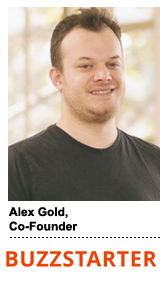 “10 Reasons Why You Should…”-type content is usually 10 reasons why you shouldn’t – and don’t.
“10 Reasons Why You Should…”-type content is usually 10 reasons why you shouldn’t – and don’t.
“Content that works is content that enraptures an audience and that means being story-driven,” said Alex Gold, co-founder of Buzzstarter, a programmatic content distribution platform based out of Silicon Valley whose clients include Dove, Yahoo, Axe, Degree, Campbell’s, Absolut Vodka and Revlon.
“I see a problem with content becoming commoditized and content marketing becoming just another part of the noise,” said Gold, who worked as an account manager at Tribal DDB and a post in the marketing and distribution department of Vuguru, the digital film studio founded by former Walt Disney Co. CEO Michael Eisner.
Buzzstarter takes a three-pronged approach to growth: distribution followed by retargeting and amplification as needed.
Recently, Buzzstarter partnered with Dove to help distribute content related to the latter’s “True Beauty” initiative. The goal was to increase views and view-throughs of video content related to the campaign and increase social engagement on Facebook, Twitter and Pinterest among a target demo of females in the northeastern US with an income of $75,000+ and an affinity for Dove products.
After natively seeding the Dove content with relevant sites and bloggers within its 60,000-strong publisher network, Buzzstarter optimized distribution among publishers whose audiences demonstrated the best social action.
The Dove distribution effort generated 254,000 unique views and 44,300 social actions, which translated to more than 17% overall engagement, with Pinterest generating the most sharing.
In that way Buzzstarter hopes to solve for the inherent conflict that can exist between growth engineering – where Gold’s co-founder, Kenzi Wang, cut his teeth as organizer of Growthathon, an annual growth hackathon he’s been running in San Francisco since 2012 – and safeguarding quality, both of content and audience.
“We don’t want brands putting content out there that hasn’t been optimized,” Gold said.
Founded in 2014, Buzzstarter has 25 employees spread across offices in San Francisco and New York, as well as a small sales/dev outpost in Los Angeles. The company raised an undisclosed amount of seed funding from China Rock Capital, Telegraph Hill Capital and 500 Startups in March 2014.
 AdExchanger caught up with Gold to chat about taking the con out of content.
AdExchanger caught up with Gold to chat about taking the con out of content.
AdExchanger: What challenges are brands facing when it comes to online content?
ALEX GOLD: For one, content will sometimes show up below the fold, and as brands become more cognizant of brand safety and only paying for viewable impressions, we need to deliver views that were really viewed and clicks that were really clicked.
Another challenge is creating content that actually tells an engaging story. Attention is the name of the game and you can’t do that with display or a recommended content solution. The only way to do that is with something like an editorial placement, a video or an infographic, not a display ad.
How do you handle the viewability question?
We don’t charge brands on an impression basis. Someone actually has to click on the content or watch the video. Content never appears below the fold because it’s always part of an actual article or post. That’s pretty different from a display unit, a banner or a footer.
How specific can you get with your targeting?
We can target by age, gender, specific geo and location. We also plug into DMPs, which allows us to understand audience interests. We can get pretty granular. If a brand is looking for moms between the ages of 25 and 40 in Anchorage, Alaska, who just bought a home, we can do it. We target based on the audience profile.
Can you share a real example of that?
We ran a campaign for Rhino Linings, which is a company that sells spray-on protective coating products for trucks.
That’s the kind of thing that is only going to appeal to a very specific audience of truck enthusiasts, most likely male truck owners between 25 and 60 years old who have either shown an interest in protective coatings in the past or who are in market to buy a liner. It’s a combination of demographic and psychographic targeting.
The owner of Rhino Linings actually became one of our investors after using our platform.
Can brands use their own first-party data for targeting?
Every brand is different, but we do integrate with DMP partners and we can pull directly from their audience profiles. If a user clicks on our content, we can cookie that user and retarget them within our network with a retargeting partner like Criteo or AdRoll. More often than not, brands will create lookalike models based on users that discover content within our network and then also do retargeting either through us or through one of our partners.














